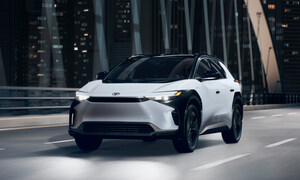PLANO, Texas, Oct. 31, 2017 /PRNewswire/ -- When Toyota launched its North American headquarters in a Hollywood, Calif., dealership on October 31, 1957, it was, no doubt, a frightening affair.
Halloween notwithstanding, a Japanese car company making a foray into the U.S. market was a bold move 60 years ago. And its first vehicle, the Toyopet Crown, didn't turn out to be a screaming success either.
But since those humble beginnings in a 3,000-square-foot, one-time Rambler dealership, Toyota has woven itself into the cultural fabric of America. Sixty years in, it encompasses a presence in every state, including 10 manufacturing facilities (14 in North America), nearly 1,500 Toyota and Lexus dealerships and 136,000 direct, dealer and supplier U.S. employees. And, the company recently unified operations by bringing together its quality engineering, sales, marketing, financial services and corporate functions in one location at a new North America headquarters campus in Plano, Texas.
"Celebrating our anniversary isn't just about the products we've sold the past 60 years," said Toyota Motor North America CEO Jim Lentz. "It's also about celebrating Toyota's thousands of employees who will help the company embark on the next leg of its American journey and continuing to improve our products and services for our customers."
To commemorate its 60th anniversary, Toyota rededicated a 50th anniversary time capsule originally dedicated at its former Torrance, Calif., headquarters in 2007. The capsule—which includes items like a 2000 GT die cast matchbox edition model car, an original key for a 1977 Toyota Hilux truck and a Toyota Formula One racer scale model—will be re-opened on the 100th anniversary in 2057. Plano Mayor Harry LaRosiliere, who attended the ceremony, said the capsule marks a new chapter for Toyota.
"As Toyota moved their North American corporate offices to Plano over the last three years, the entire region has experienced the positive impact of their team members unique character and culture. The entire organization exhibits a sense of purpose, innovation, and family. We are proud they call Plano home, and we are honored to be part of today's anniversary celebration," LaRosiliere said. "We look forward to the next 60 years with Toyota in the City of Plano."
The Metal
Toyota's American journey has been fueled by the cars it makes. In the 1950s that meant the Toyopet Crown and the now-legendary Land Cruiser. Introduced in the '60s, the Corolla would go on to become the bestselling nameplate in the world.
The '70s got sporty with the Celica and the beloved Supra, while the '80s introduced the American public to Camry and 4Runner, among others.
In 1989, Toyota launched its luxury vehicle division, Lexus, in the U.S. with two models, the LS 400 and ES 250.
In the '90s, Toyota filled out its lineup with models like the Tacoma, RAV4, Avalon and Sienna, and from Lexus, the GS, LX and RX.
In 2003, Toyota launched Scion to bring in younger customers and to test out revolutionary processes and products. As a result, the xB became an icon for a new millennium.
And, Toyota changed the world by pushing hybrid technology into the American mainstream with the Prius, which surfaced in 1997 and launched in the U.S. in 2000. More than a decade later, the iconic Prius was followed by another alternative fuel vehicle, the hydrogen fuel cell powered Mirai.
Manufacturing, Engineering and Captive Finance
The '70s were critical to operations. Toyota marked its first U.S. production, signing Atlas Fabricators of Long Beach (later changed to TABC) to make truck beds. Toyota Technical Center, which just celebrated its 40th anniversary in May, opened its first U.S. R&D facility and Calty Design Research opened its doors in Southern California.
Growth continued into the '80s with the launch of manufacturing facilities in California and Kentucky. In addition, Toyota Motor Credit Corporation (now known as Toyota Financial Services), began operations in the U.S. in October 1982.
In the '90s and '00s, Toyota added vehicle and parts plants in Indiana, West Virginia, Alabama, Tennessee, Texas, Missouri and Mississippi. To support the rapid growth, Toyota consolidated its R&D and manufacturing operations under a single company in 2006.
The Future
Over the years, Toyota Motor North America has transformed from just a sales company into a mobility company.
In 2016, the Toyota Research Institute launched, leading the way to autonomous vehicles, robotics, vehicle safety and materials science. In the same year, Toyota Connected was created to use data to personalize the customer driving experience.
What started as a single store in Southern California has evolved into an American institution that continues to bring jobs, mobility and technology to its communities.
About Toyota
Toyota (NYSE:TM) has been a part of the cultural fabric in the U.S. and North America for 60 years, and is committed to advancing sustainable, next-generation mobility through our Toyota and Lexus brands. During that time, Toyota has created a tremendous value chain as our teams have contributed to world-class design, engineering, and assembly of more than 33 million cars and trucks in North America, where we operate 14 manufacturing plants (10 in the U.S.) and directly employ more than 46,000 people (more than 36,000 in the U.S.). Our 1,800 North American dealerships (nearly 1,500 in the U.S.) sold almost 2.7 million cars and trucks (2.45 million in the U.S.) in 2016 – and about 85 percent of all Toyota vehicles sold over the past 15 years are still on the road today.
Toyota partners with community, civic, academic, and governmental organizations to address our society's most pressing mobility challenges. We share company resources and extensive know-how to support non-profits to help expand their ability to assist more people move more places. For more information about Toyota, visit www.toyotanewsroom.com.
Media Contact:
Media Line
(469) 292-2636
SOURCE Toyota Motor North America
WANT YOUR COMPANY'S NEWS FEATURED ON PRNEWSWIRE.COM?
Newsrooms &
Influencers
Digital Media
Outlets
Journalists
Opted In






Share this article